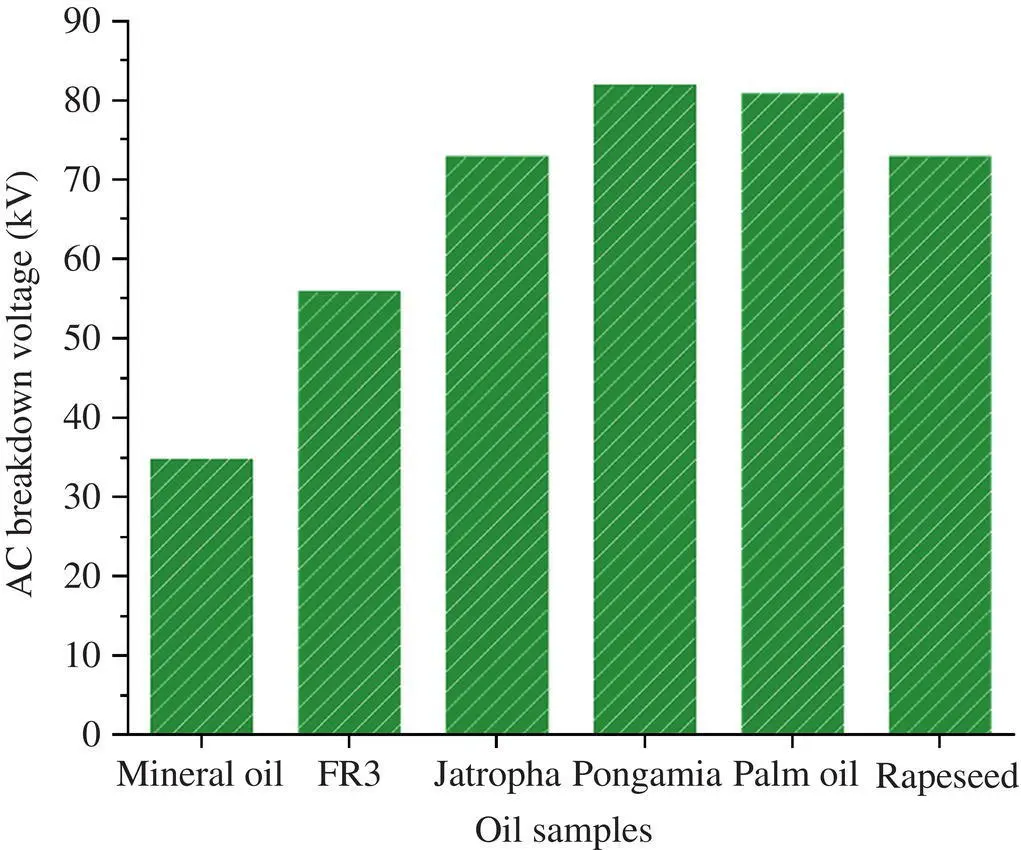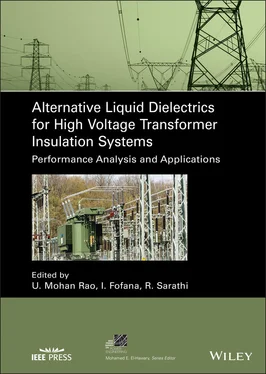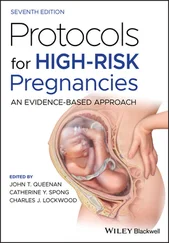The composition of Pongamia and Jatropha oils is presented in Tables 2.3and 2.4, respectively.
Table 2.3 Composition of Pongamia.
| FAME |
Molecular formula |
Retention time (min) |
Molar mass (g/mol) |
| Hexadecanoic acid |
C 17H 34O 2 |
22.48 |
270 |
| 11‐Octadecenoic acid |
C 19H 36O 2 |
24.33 |
296 |
| Octadecenoic acid |
C 18H 34O 2 |
24.46 |
282.47 |
| CIS‐11‐Eicosanoic acid |
C 20H 38O 2 |
26.06 |
310.51 |
Table 2.4 Composition of Jatropha.
| FAME |
Molecular formula |
Retention time (min) |
Molar mass (g/mol) |
| 9‐Hexadecanoic acid |
C 17H 34O 2 |
36.31 |
268 |
| Hexadecanoic acid |
C 17H 34O 2 |
36.525 |
270 |
| Pentadecanoic acid |
C 16H 32O 2 |
36.55 |
256 |
| 9‐Octadecenoic acid |
C 19H 36O 2 |
38.52 |
296 |
| Heptadecanoic acid |
C 19H 38O 2 |
38.741 |
298 |
2.4 Properties and Evaluation of Natural Esters
There are many properties of natural esters that are superior than the conventional MOs used in transformers. However, in some areas, the natural esters do show some drawbacks which need to be improved to utilize it to its full potential as an insulating liquid. A few of the properties are listed below.
2.4.1 Electrical Properties
2.4.1.1 AC Breakdown Voltage (ACBDV)
The quality of the dielectric insulating oil is studied and assessed by performing the AC breakdown voltage (ACBDV) test. It is conducted using BAUR DTA 100C as per the standard IEC 60156. ACBDV of insulating liquid is the prime parameter in defining its electric characteristics. The ACBDV is affected adversely by conducting particles, moisture content, and air/gas bubbles formed in the transformer insulating liquid. The measured ACBDV indicates the integrity of the oil and gives a superior value when the oil is impurity free. The oil acts as an insulating agent and a coolant in a power transformer. Apart from the solid insulation like kraft paper and pressboard, the composite oil–paper system gives an effective insulation system to the transformer. Some studies reported enhanced values of NEOs to conventional MO in comparison [47]. Some natural esters have an ACBDV of more than twice the values of the conventional oil, which indicates that natural esters can provide better resistance to high electrical stress in comparison to MO [52]. There is a huge variation in the level of water solubility of natural ester and MO, and ACBDV greatly depends on these moisture levels [53]. The tests conducted on samples of NEOs have a higher value of water content in comparison to conventional oil. This happens because of the chemical structure of the natural esters, which has higher saturation limits in water content than that of MO. Water content level of 200 ppm in NEO has a relative humidity value of 26.7%, which is equivalent to 10 ppm of water content in MO [54]. It is observed from Figure 2.5that the ACBDV of NEOs like pongamia, jatropha, and palm oil is better than MO. Hence, with all these evidences, it is clear that NEO has comparatively higher moisture saturation levels than MO, and performance of NEO is significantly better than MO.
2.4.1.2 Dielectric Dissipation Factor (DDF)
The DDF is a measure of power loss when an external field is applied to an insulating medium. It gives tangent of the dielectric loss angle which is also known as loss factor or tan‐ δ . The insulation (of any HV equipment) can be represented as a series or parallel combination of a capacitance and a resistance.
2.4.1.2.1 Parallel Representation
The complex permittivity of any dielectric medium can be represented as ε c, is denoted in (2.1),
(2.1) 
where σ is the conductivity and ω is the frequency of the source. The real part ε r ′ is the measure of how much energy is stored by the material and the ε r ″ represents how dissipative a material can be in reaction to an external electric field. On the application of an AC sinusoidal voltage source to the lossy dielectric in parallel combination with resistance R pand capacitance C p, the resultant current I is composed of two components: the conduction current I cand the displacement current I d, as seen in Figure 2.6a and b, which is related to the DDF as given in (2.2),

Figure 2.5 Comparison of ACBDV values of different oil samples.

Figure 2.6 (a) Parallel representation of the insulation. (b) Phasor diagram for parallel circuit. (c) Series representation of the insulation. (d) Phasor diagram for series circuit.
(2.2) 
The power loss P can be represented in Eq. (2.3),
(2.3) 
2.4.1.2.2 Series Representation
The application of an AC sinusoidal voltage source to the lossy dielectric in series combination with resistance R sand capacitance C sgives two components of voltage  and
and  across the resistor and capacitor, respectively, as seen in Figure 2.6c. The power factor angle is represented by φ in Figure 2.6d. The cotangent of the power factor angle is given by the equation:
across the resistor and capacitor, respectively, as seen in Figure 2.6c. The power factor angle is represented by φ in Figure 2.6d. The cotangent of the power factor angle is given by the equation:
(2.4) 
So, the loss tangent may be written as:
(2.5) 
The power loss is given by:
(2.6) 
(2.7) 
Читать дальше






 and
and  across the resistor and capacitor, respectively, as seen in Figure 2.6c. The power factor angle is represented by φ in Figure 2.6d. The cotangent of the power factor angle is given by the equation:
across the resistor and capacitor, respectively, as seen in Figure 2.6c. The power factor angle is represented by φ in Figure 2.6d. The cotangent of the power factor angle is given by the equation:














